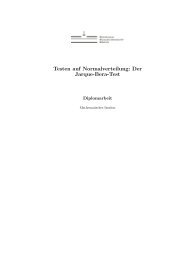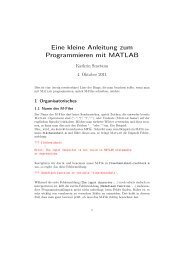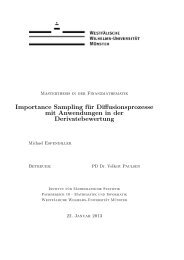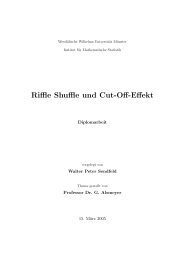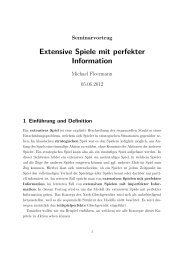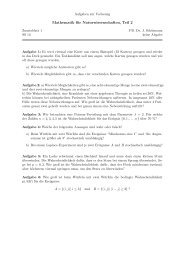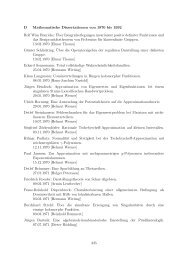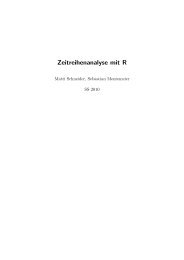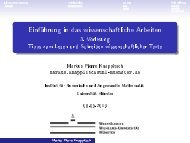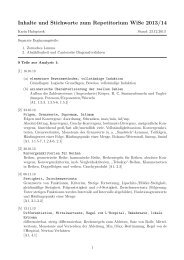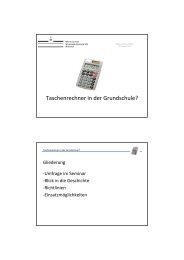Margulis Lemma
Margulis Lemma
Margulis Lemma
You also want an ePaper? Increase the reach of your titles
YUMPU automatically turns print PDFs into web optimized ePapers that Google loves.
8 VITALI KAPOVITCH AND BURKHARD WILKING<br />
Remark 1.9. a) The example shows that it is difficult to relate an open subgroup<br />
in the limit to corresponding subgroups in the sequence.<br />
b) If g1, i . . . , gh i i<br />
is a generator system of some subgroup Γ ′ i ⊆ Γ i, then one can<br />
consider – after passing to a subsequence – a different limit construction to<br />
get a subgroup G ′ ⊂ G: For some fixed R consider all words w in g1, i . . . , gh i i<br />
with the property w ⋆ p i ∈ B R (˜p i ). This defines a subset in the Cayley<br />
graph of Γ ′ i . Consider now all elements in Γ′ i represented by words in the<br />
identity component of this subset. Passing to the limit gives a closed subset<br />
S R ⊂ G of the limit group and one can now take the limit of S R for R → ∞.<br />
This sort of word limit group can be much smaller than the regular limit<br />
group as the above examples shows. Although it depends on the choice<br />
of the generator system, there are occasions where this limit behaves more<br />
natural than the usual. However, this idea is used only indirectly in the<br />
paper.<br />
1.4. Notations and conventions. Throughout the paper we will use the following<br />
conventions.<br />
• As already mentioned − ∫ S f dµ stands for ∫<br />
1<br />
vol(S) S f dµ.<br />
• Mx(f)(x) denotes the maximum function of f evaluated at x, see <strong>Lemma</strong> 1.4<br />
for the definition.<br />
• A map σ : X → Y between inner metric spaces is called a submetry if<br />
σ(B r (p)) = B r (σ(p)) for all r > 0 and p ∈ X.<br />
• If S ⊂ F is a subset of a group, then 〈S〉 denotes the subgroup generated<br />
by S.<br />
• If g 1 and g 2 are elements in a group, [g 1 , g 2 ] := g 1 g 2 g1 −1 g−1 2 denotes the<br />
commutator. For subgroups F 1 , F 2 we put [F 1 , F 2 ] := 〈{[f 1 , f 2 ] | f i ∈ F i }〉.<br />
• Generators b 1 , . . . , b n ∈ F of a group are called a nilpotent basis if [b i , b j ] ∈<br />
〈b 1 , . . . , b i−1 〉 for i < j.<br />
• N ⊳ F means: N is a normal subgroup of F.<br />
• For a Riemannian manifold (M, g) and λ > 0 we let λM denote the Riemannian<br />
manifold (M, λ 2 g).<br />
• For a limit space Y a tangent cone C p Y at p is some Gromov–Hausdorff<br />
limit of (λ i Y, p) for some λ i → ∞. Tangent cones are not always cones and<br />
are not necessarily unique.<br />
• For a limit space Y of manifolds with lower Ricci curvature bound a regular<br />
point p ∈ Y is a point all of whose tangent cones at p are given by R kp . By<br />
a result of Cheeger and Colding [CC97] these points have full measure and<br />
are thus dense.<br />
• For two sequences of pointed metric spaces (X i , p i ), (Y i , q i ) and maps<br />
f i : X i → Y i we use the notation f i : [X i , p i ] → [Y i , q i ] to indicate that<br />
f i converges in some sense to a map from the pointed Gromov–Hausdorff<br />
limit of (X i , p i ) to the pointed Gromov–Hausdorff limit of (Y i , q i ). It usually<br />
does not mean that f i (p i ) = q i . However, if this is the case we write<br />
f i : (X i , p i ) → (Y i , q i ).<br />
• If a group G acts on a metric space we say g ∈ G displaces p ∈ X by r if<br />
d(p, gp) = r. We will denote the orbit of p by G ⋆ p.<br />
• Gromov’s short generator system (or short basis for short) of a fundamental<br />
group is defined at the beginning of section 1.



